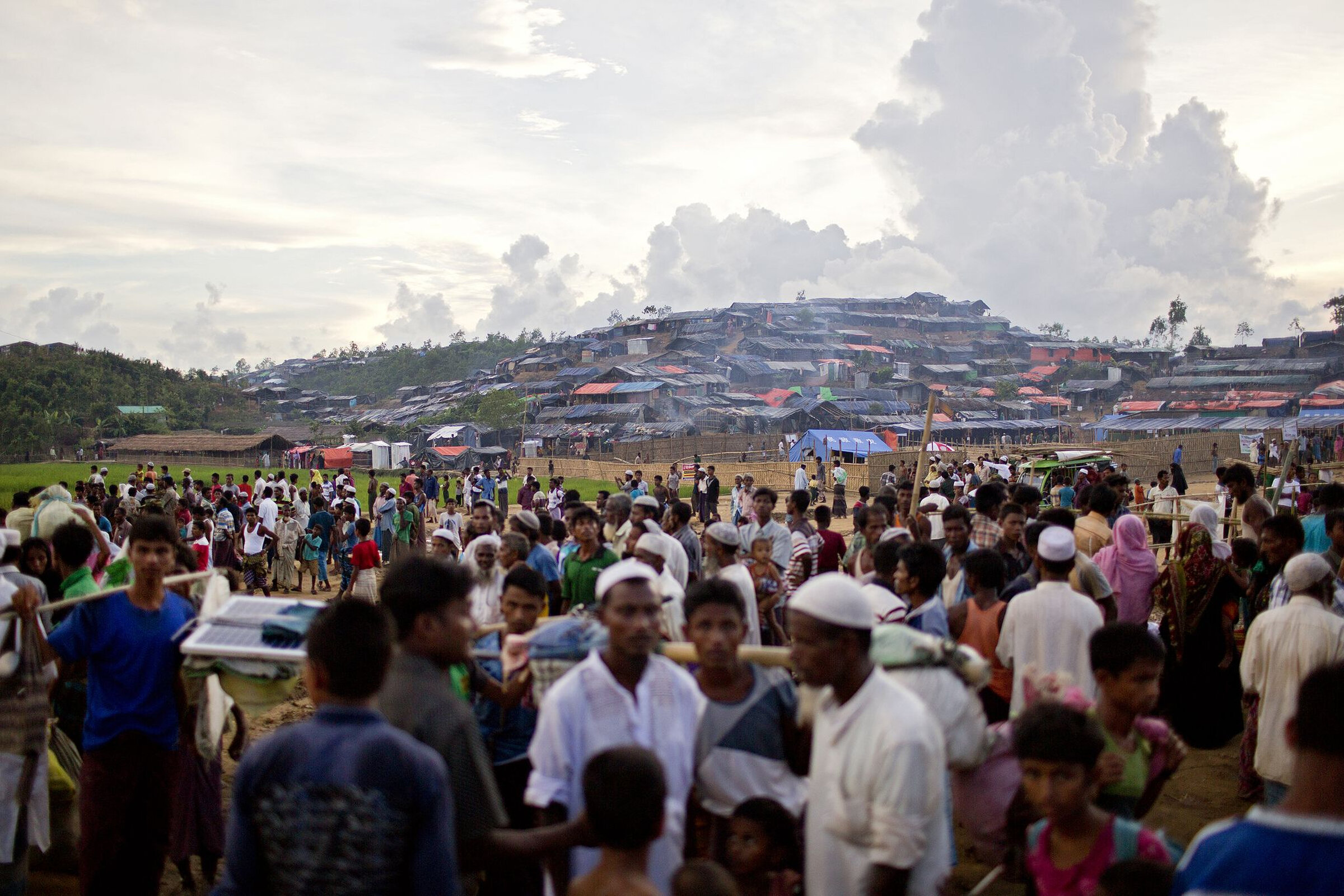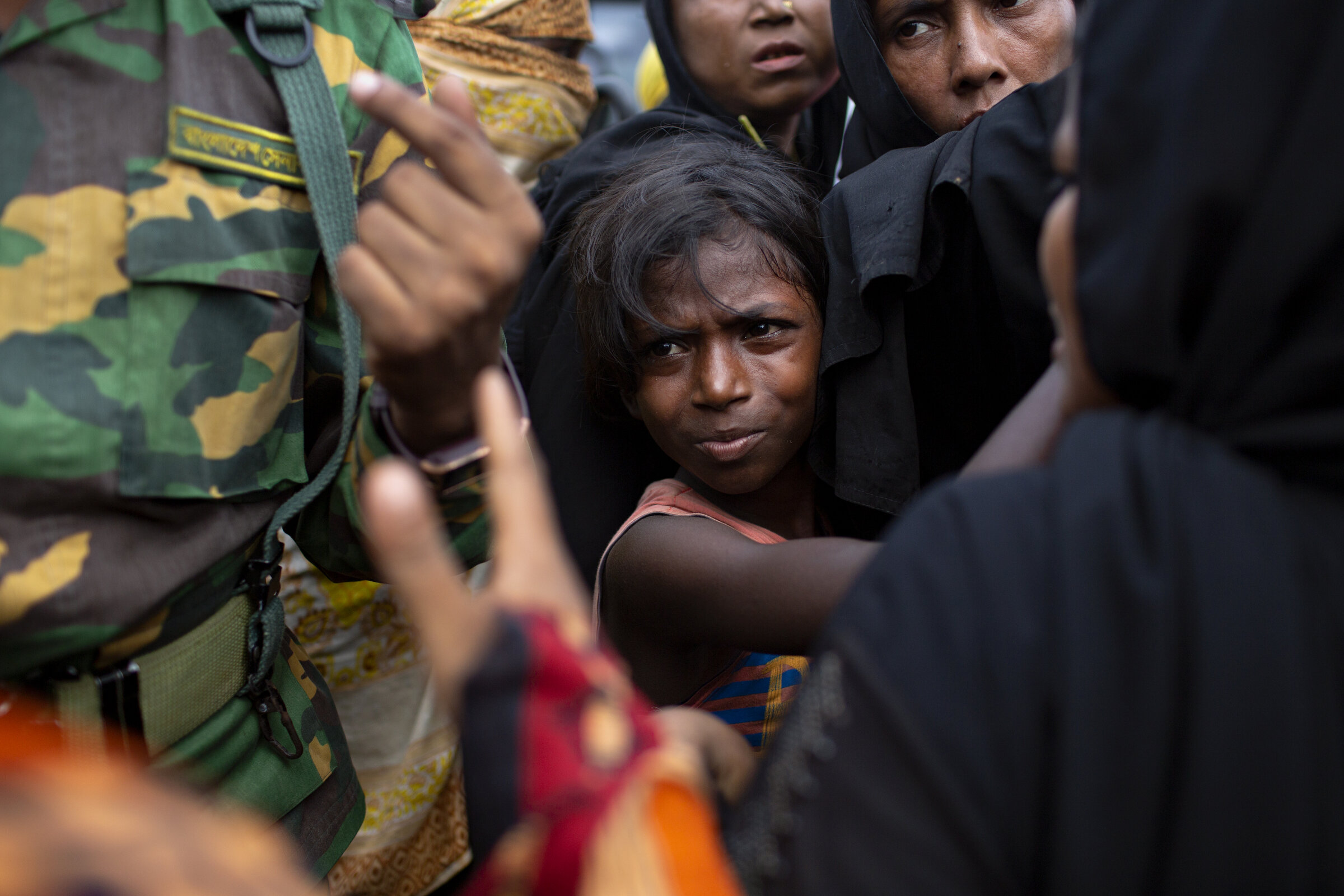Rohingya women and children walk through a refugee camp outside of Cox’s Bazar, Bangladesh, where nearly a million people have taken refuge after fleeing Myanmar.
Rohingya refugees cross a bamboo bridge in a refugee camp. The Rohingya, a largely Muslim ethnic minority, has suffered systemic discrimination and persecution by the Myanmar government for decades and are not allowed citizenship in Myanmar.
A Rohingya woman strokes the head of her son in a refugee camp. “You’re seeing so many more single women with their children and a lot of them know that their husband has been murdered. Some don’t know what’s happened to their husband. Some have left them behind because they're trying to save their house, their home," says Laureli Morrow, founder of NGO Midwife Pilgrim, a nonprofit organization that provides women’s health care to communities in crisis and disaster.
Mohammed Alam, left, shows the burn scars on his 2-year-old son that he told me were caused when members of the Myanmar military burned down their home in Myanmar. They are now living in Balukhali refugee camp outside of Cox's Bazar, Bangladesh. “I want the world to know that the Burmese military is doing this to us”, he told me.
A pregnant Rohingya woman waits for a medical screening at a health tent in a refugee camp. After a small group of men from the Arakan Rohingya Solidarity Army killed 12 Myanmar police officers in 2017, the Myanmar military, along with Buddhist militia and local security forces, conducted “clearance operations” against the Rohingya; they burned villages, killed en masse, gang-raped Rohingya civilians, and destroyed their homes and schools. Infanticide was also been reported.
Staff members of a clinic speak with a Rohingya woman at a clinic outside of Cox’s Bazar, Bangladesh.
Hasina Khatun lies with her newborn baby after a caesarean section at the HOPE hospital located outside of Cox's Bazar, Bangladesh. All care at the hospital, including surgery, is provided free of charge for Rohingya women and children.
Senowara Begum holds her 1-year-old malnourished child in their tent in Thainkhali refugee camp. Begum's child is receiving treatment at an outpatient centers for children with malnutrition. According to Concern Worldwide's nutrition advisor Asfia Azim, “the rate of severe acute malnutrition [in the camps] is extremely high”.
The Thainkhali refugee camp outside of Cox's Bazar, Bangladesh. UNHCR has described the Rohingya refugee crisis as the fastest-growing refugee emergency in the world today.
Young Rohingya refugees wash clothes in a pond in a refugee camp. Aid workers have expressed concern that the thousands of minors navigating the area unaccompanied by adults may be at risk of human trafficking, sexual assault, and child labor. “Yes, we’re hearing about trafficking. We’re hearing that Rohingya women are being taken from the camps at night,” says Siobhán Foran, a Gender in Emergencies Coordinator for CARE International.
Hasion carries his sick 4-year-old daughter, who doctors said is suffering from a fever and diarrhea, to a vehicle that will transport her to the nearest hospital.
Rohingya woman Jaheda Begum, 22, center, speaks with nurses at the HOPE hospital. Begum said she fled from Myanmar to Bangladesh after the military attacked her village and her husband and brother-in-law died. Although she crossed the border with her sister, she said that they lost each other along the way and now she is uncertain of her whereabouts.
22-year-old Jaheda Begum lies on an operating table after her fistula was examined by a doctor at HOPE hospital. Begum will receive surgery for fistula repair in a few days. “I need food, I need shelter, and I also need justice for the Myanmar Government because they are brutally torturing my village," she said.
Nurses speak with Sayeda Begum at the HOPE hospital before her fistula repair surgery.
A nurse comforts Sayeda Begum at the HOPE hospital before her fistula repair surgery.
Rohingya people, who have newly arrived from Myanmar, stand along the roadside of a refugee camp.
A woman looks out from a tent in a refugee camp.
Women stand in line for medication at a health clinic located in the Balukhali refugee camp.
Md Zabed, center, looks up at a volunteer doctor who visits his sick wife in their tent in Balukhali refugee camp. He said that after their village was burned by the Myanmar military, his family fled to Bangladesh, a journey that took a week and during which they hid in the jungle.
Newly arrived Rohingya refugees wait in line to be registered by the Bangladesh military in Balukhali refugee camp. According to an IRC assessment done in partnership with Relief International, “87% of families have at least one member with an identified vulnerability”, which includes older people, pregnant women, and people who have a disability or are wounded.
Young children gather water at a Rohingya refugee camp. Access to water is a crucial issue for refugees in the camps. “[This situation] has the hallmarks for an outbreak. You have very close living, you're coming up to the monsoon season, you've got open defecation, you've got malnutrition—both severe and moderate—and you've got lack of hygiene. Ultimately the prevention of an outbreak is what we are always trying to target”, said Damian Seal, who is Concern Worldwide's Emergency Program Manager for water, sanitation, and hygiene.























![Young children gather water at a Rohingya refugee camp. Access to water is a crucial issue for refugees in the camps. “[This situation] has the hallmarks for an outbreak. You have very close living, you're coming up to the monsoon season, you've got](https://images.squarespace-cdn.com/content/v1/5e92f865fd7a75746164346c/1595519659811-A3UOYHFGZX73YSE0O7DR/D.VILLASANA_ROHINGYA_17.JPG)